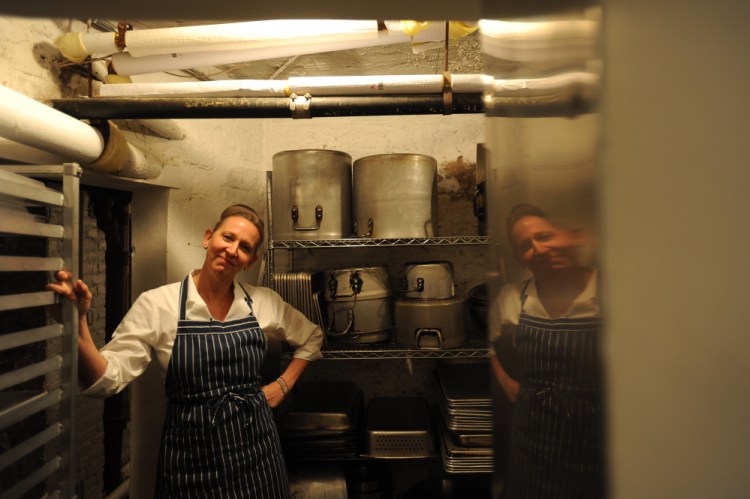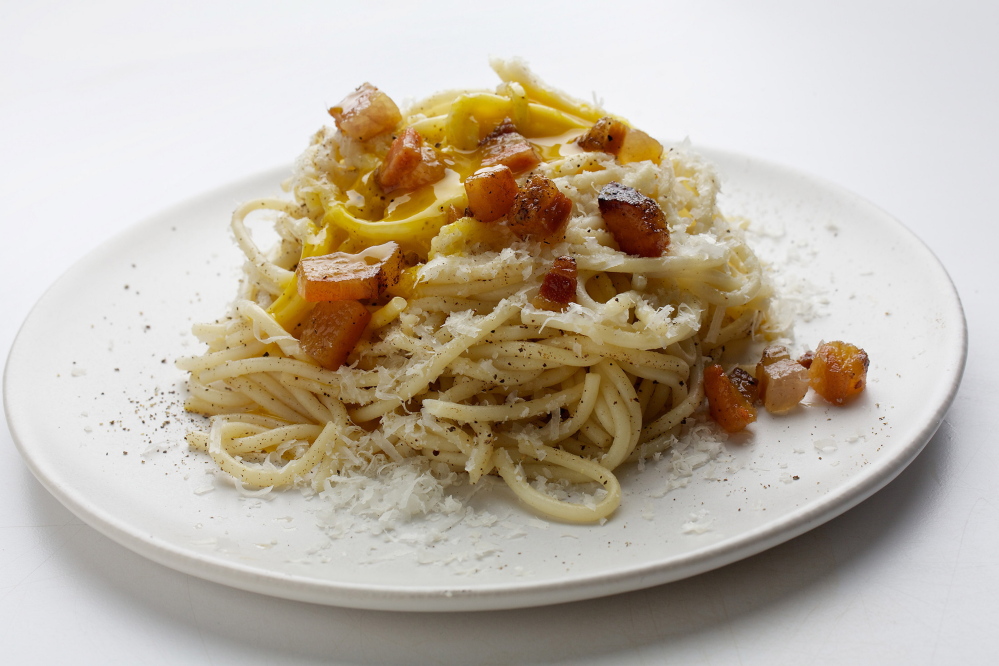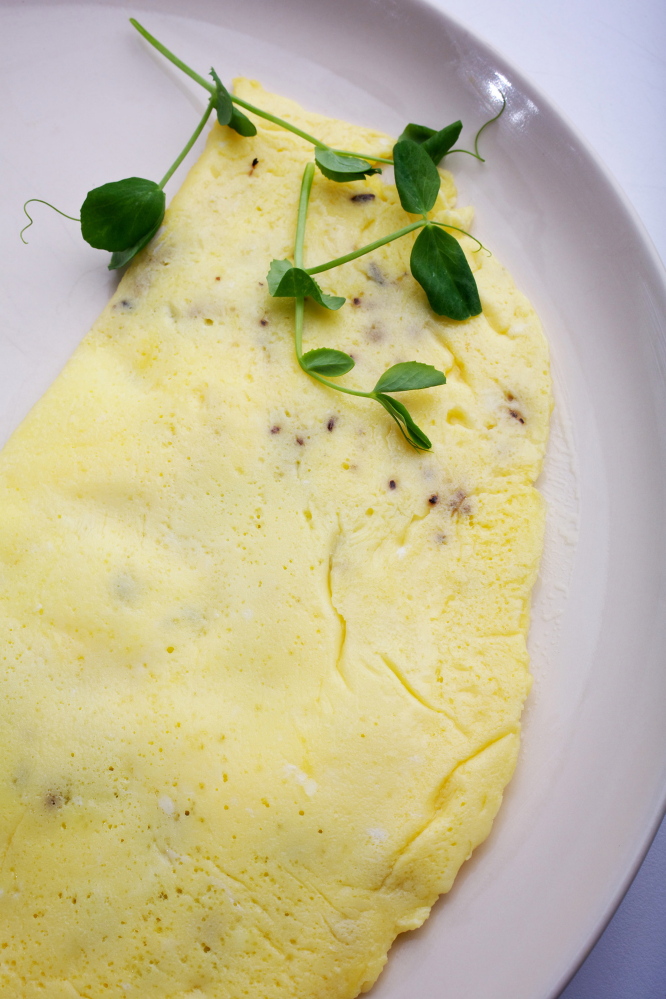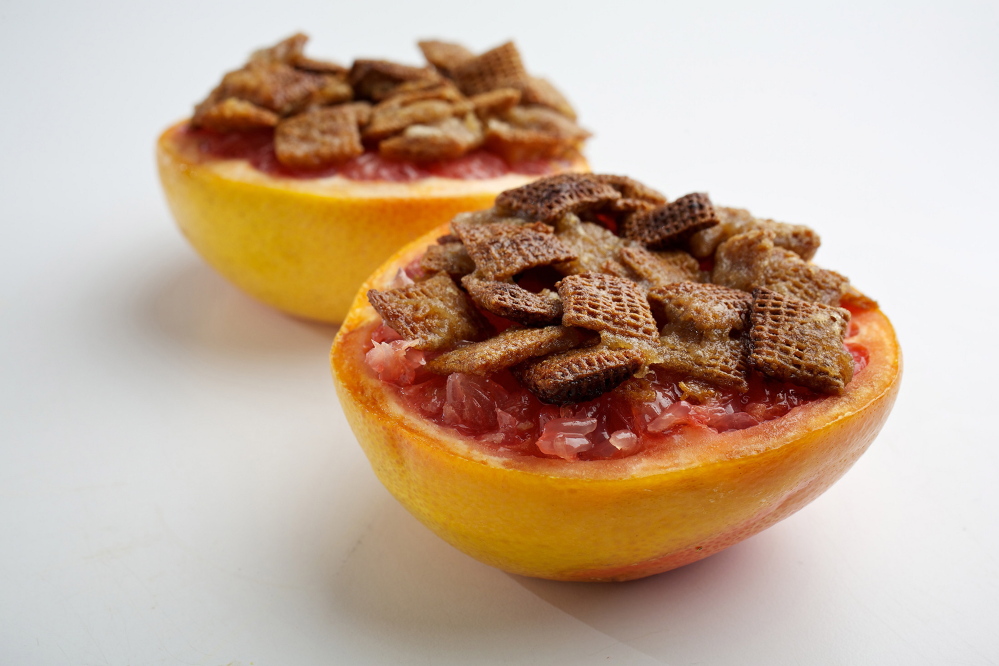NEW YORK – At 10:15 on a miserably rainy morning, a crowd huddled under the pink awning outside Prune. The restaurant, in the East Village, had been open for only 15 minutes, and already every one of its 30 seats was taken and the wait was about 25 minutes. And no, if I went to the nearby coffee shop, the hostess would not call my cellphone to tell me my table was ready.
This sounds like the kind of story that starts many rants about the “problems with brunch”: the second-rate cooks who turn out rubbery omelets and the weak bloody marys, which make free refills more a necessity than a perk. But brunch at Prune is divine.
There’s the famous spaghetti alla carbonara: salty, rich, the pasta cooked just shy of al dente, a far more satisfying way to get your bacon and eggs. There’s an omelet with toasted caraway and sour cream, and a plate of grilled lamb sausage served with oysters on the half shell. The dishes are different enough to be interesting but not so challenging as to irritate patrons who still have not had their first cup of coffee – or a hangover-relieving Alka-Seltzer, which is always available at the bar. More important, every dish is cooked with the precision you expect when you’re plunking down $12 to $18 a plate.
Brunch at Prune is emblematic of its chef-owner Gabrielle Hamilton’s approach to food: honest, unconventional and defiantly unpretentious. The same is true of her new cookbook, “Prune” (Random House), published to coincide with the restaurant’s 15th anniversary. The book was conceived as the antithesis of the “food porn” that celebrity chefs routinely use to cement their images. “Prune” has no lush photos of Hamilton shopping at farmers markets, or even literary essays, despite the fact that she is the author of the critically acclaimed memoir “Blood, Bones and Butter.”
Instead, it is an old-fashioned cookbook because it includes pretty much just recipes – a kind of culinary companion to her memoir (in which she refused to include recipes, much to her publisher’s dismay). “Cookbooks are a little confused now,” Hamilton said. “They are art books or half-memoir, half-recipes. This is a cookbook. It tells you what we do to get our food to taste this way.”
The emphasis is on “we.” When Hamilton began to work on “Prune,” she says, she tried to write to the home cooks who might be using it. But “in about 15 seconds flat, I realized I was lying my brains out,” she said. “What I know and what I can really tell the truth about is what I’ve been doing every day for 15 years, which is cooking in a restaurant.”
And so Hamilton wrote the book as if she were speaking to her own line cooks. It has no inspirational or scene-setting headnotes. Its annotations, which are written in Hamilton’s own neat hand, are a mixture of warnings, advice and encouragement for those cooks. The conceit is sometimes discomfiting but stunningly original. In the blizzard of aspirational, look-alike cookbooks, “Prune,” like its namesake, stands apart.
Some of Hamilton’s notes might be useful for home cooks anyway. When writing about fruit salads, for instance, she insists that cooks use the blue cutting boards otherwise reserved for pastry: “I have tasted our fruit salad when one of you has carelessly used the all-purpose cutting boards, and no matter how well they were washed and sanitized, there can sometimes be a lingering, remote onion/garlic tinge.” Good advice. She also recommends – demands, really – specific brands for some ingredients: Pepperidge Farm sandwich bread and College Inn chicken broth (far from fussy “chef” ingredients) are called for in various recipes.
Other suggestions probably won’t be so helpful to non-professionals, such as her tip that an ill-fitting pot lid can be covered with cling film, then foil, to give a secure seal. (That works only with restaurant-quality plastic wrap, which can withstand such heat.)
But even those ideas can be interesting, because they paint an honest, unglamorous version of what it is like to work in a restaurant. In the recipe for Serrano ham, fried pistachios and figs, Hamilton instructs her cooks to put the ham in the oven if the Health Department happens to show up. (New York regulations require that meat be chilled or hot and not kept at room temperature for more than four hours.) To the cook assigned the dreaded task of making 40 Monte Cristo sandwiches for brunch, Hamilton advises waiting until the end of the day, when the prep kitchen is quiet and the bread can be laid like an assembly line. This “will spare you sinking down into the hopeless despair that can sometimes overtake the lone brunch prepper.”
The stories layered inside the recipes are a bonus, because Hamilton set out to make her cookbook a distinctly unliterary effort. By 2012, she had racked up a string of professional triumphs, including two James Beard awards: one for the Best Chef in New York City, the other for “Blood, Bones and Butter,” which Anthony Bourdain, a celebrity chef with his own literary chops, called “the best memoir by a chef ever.” In light of that success, Hamilton was afraid that critics would be looking to tear her down and that her next book would flop: “I thought, ‘Oh, I’m going to skip that whole sophomore-effort nervousness by writing a cookbook. How hard can that be? And, of course, I learned.”
Hamilton, who turns 49 this month, is tall and very thin, with bleached-blond hair, startlingly blue eyes and a tongue stud that gives her a subtle lisp. She is intense, a trait that is equal parts intimidating and captivating. And over the past 15 years, her restaurant has had a formidable influence on New York and beyond. Prune proved that an unfussy, cramped, noisy restaurant could, as then-New York Times critic Frank Bruni wrote, “accord homey cooking as much honor as haute cuisine.”
But whether “Prune” will have as formidable an influence on the cookbook world is questionable. Cookbooks in the 21st century are as much about burnishing reputations and setting a mood as they are about cooking. Moreover, a truly old-fashioned cookbook expects, as Hamilton does to some extent in “Prune,” that its readers have some notion of how to cook. “She says ‘trim the asparagus and cook them till they are done,’ ” observed Ruth Reichl. “That assumes a fair amount of knowledge.”
Reichl, the last editor of Gourmet magazine, who has her own recipe-memoir book coming out next year, says that in the years before the magazine’s demise in 2009, editors were instructed to assume nothing. If they ran a recipe for duck a l’orange, readers needed to know not only how to steam a duck and make the sauce, but how and where to buy a duck in the first place. She’s thrilled by Hamilton’s confidence that such considerations are no longer necessary: “I hope she is right.”
It’s true that telling many home cooks to boil asparagus “au point” will not be enough information to help them get dinner on the table. But while many of Hamilton’s instructions do not provide the usual details, they are more evocative (and certainly more fun) than definitions and cooking times. In a recipe for pole beans braised in olive oil with anise hyssop, she tells her cooks that “we want them really soft-cooked, drab, lusciously oily – like they would do at a village restaurant on a remote Greek island.” The image tells cooks all they need to know.
“Prune” does another thing, too. It proves that even a recipe offers opportunities for beautiful prose, such as her description of short ribs barely submerged in a pho broth as “crocodiles in a swamp.”
“You can use this book any way you want,” says Hamilton. “You can get in and get your bloody mary recipe. Or you can lie in bed at night with it, with no intention of making anything. This is the truth of what we do here. And you’re welcome to it.”
Prune Spaghetti Alla Carbonara
2 servings
Like the Italian recipes that are widely considered authentic, Gabrielle Hamilton’s restaurant recipe contains no milk or cream. It relies on top-quality cheese, pancetta (salt-cured Italian bacon) and pasta.
5 ounces pancetta, cut into 1/2-inch cubes
Kosher salt
4 ounces dried spaghetti, preferably an imported Italian brand
2 or 3 large egg yolks, at room temperature
1 to 2 teaspoons freshly ground black pepper
1/3 cup freshly grated Parmigiano-Reggiano cheese
Warm two serving bowls.
Scatter the pancetta evenly in a cast-iron skillet. Cook gradually over medium-low heat, stirring occasionally, until much of its fat has rendered and the meat has crisped (about 10 minutes). Transfer the rendered fat and the crisped pancetta to a bowl; cover loosely to keep warm.
Meanwhile, bring a pot of water to a boil over medium-high heat. Add a generous pinch of salt, then the pasta. Cook according to the package directions, just until al dente. Turn off the heat.
Combine the egg yolks (to taste) and a spoonful or two of the rendered pancetta fat in a mixing bowl. Sprinkle with black pepper until evenly, yet lightly, dusted.
Use tongs to transfer the pasta to the egg yolk mixture, letting some of the cooking water drip in as well. Stir quickly to coat the pasta, warming the yolks in the process. Season lightly with salt and the cheese.
Divide between warmed bowls; top with the crisped pancetta. Serve right away.
Ingredients are too variable for a meaningful analysis.
Sour Cream and Toasted Caraway Omelet
1 serving
At Prune, chef Gabrielle Hamilton likes the omelet folded in half in the pan, cooked just long enough to set but not enough to pick up color, and served with the curved edge adjacent to the curved edge of the plate.
2 teaspoons caraway seeds
2 large eggs
1 tablespoon heavy cream
1 tablespoon unsalted butter
2 tablespoons sour cream, whipped smooth with a spoon, at room temperature
Kosher salt
Freshly ground black pepper
Warm a plate.
Toast the caraway seed in an 8-inch skillet over medium heat until fragrant and lightly browned, shaking the pan to avoid scorching. Transfer to a plate; cool, then crush the seeds.
Use a fork to thoroughly whisk together the eggs and cream in a medium bowl until the mixture is an evenly colored pale yellow.
Melt the butter in the same skillet, over medium-low heat, just until foamy. Pour in the egg mixture; cook undisturbed for a few minutes, so the bottom sets.
As the eggs cook at the center, pull a flexible spatula across the eggs’ surface, until they are just set. Gently smooth/tuck in the outer edges so they do not become dry and wispy. Turn off the heat.
Spoon the sour cream and the toasted, crushed caraway seed down the center of the omelet. Season the eggs lightly with salt and pepper. Use the spatula to fold the omelet in half; it should not be browned on either side.
Turn the omelet onto the warmed plate. Serve right away.
Nutrition per serving: 370 calories, 14 g protein, 4 g carbohydrates, 33 g fat, 17 g saturated fat, 440 mg cholesterol, 400 mg sodium, 2 g dietary fiber, 2 g sugar
Broiled Ruby Red Grapefruit With Wheat Chex Streusel
4 servings
Simple ingredients, used to stunning effect. This can be done in the toaster oven.
MAKE AHEAD: Leftover (unbroiled) streusel can be frozen in an airtight container for up to 1 week.
4 tablespoons cold, imported unsalted butter, preferably French, cut into small pieces
1/2 cup lightly packed light brown sugar
2 cups Wheat Chex cereal
2 large ruby red grapefruit
Position an oven rack 6 inches from the broiler element; preheat the broiler. Line a baking sheet with aluminum foil.
Combine the butter and brown sugar in a mixing bowl and use your fingers to work them into a well-marbled mixture. Add the Wheat Chex; use your fingers to work the butter-sugar into the cereal to form a streusel, trying not to crush the Wheat Chex too much.
Cut the grapefruit in half through their equators; discard any seeds. Carefully loosen their segments but leave them in place. Place the halves on the baking sheet. If they seem unsteady, trim a thin slice of peel from the bottom. Pack the streusel evenly on top of each grapefruit half; you might not use all of it.
Broil for about 1 minute, just until glistening and golden brown; you’ll smell the butter. You don’t want to smell, or see, burnt Wheat Chex, so watch closely after the first 30 seconds.
Serve warm.
Nutrition per serving: 290 calories, 3 g protein, 53 g carbohydrates, 9 g fat, 6 g saturated fat, 25 mg cholesterol, 140 mg sodium, 5 g dietary fiber, 34 g sugar
All recipes adapted from Gabrielle Hamilton’s “Prune” (Random House, 2014).
Send questions/comments to the editors.






Success. Please wait for the page to reload. If the page does not reload within 5 seconds, please refresh the page.
Enter your email and password to access comments.
Hi, to comment on stories you must . This profile is in addition to your subscription and website login.
Already have a commenting profile? .
Invalid username/password.
Please check your email to confirm and complete your registration.
Only subscribers are eligible to post comments. Please subscribe or login first for digital access. Here’s why.
Use the form below to reset your password. When you've submitted your account email, we will send an email with a reset code.